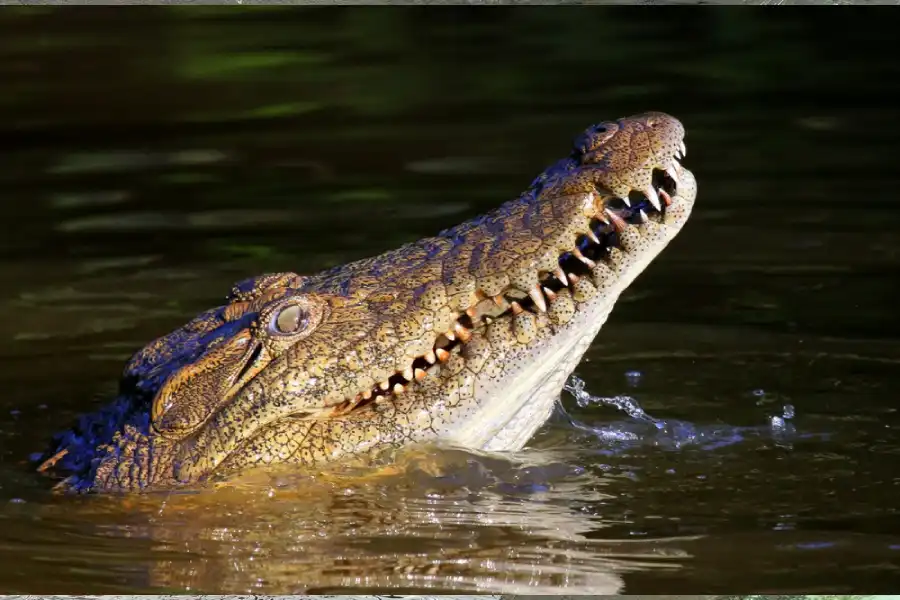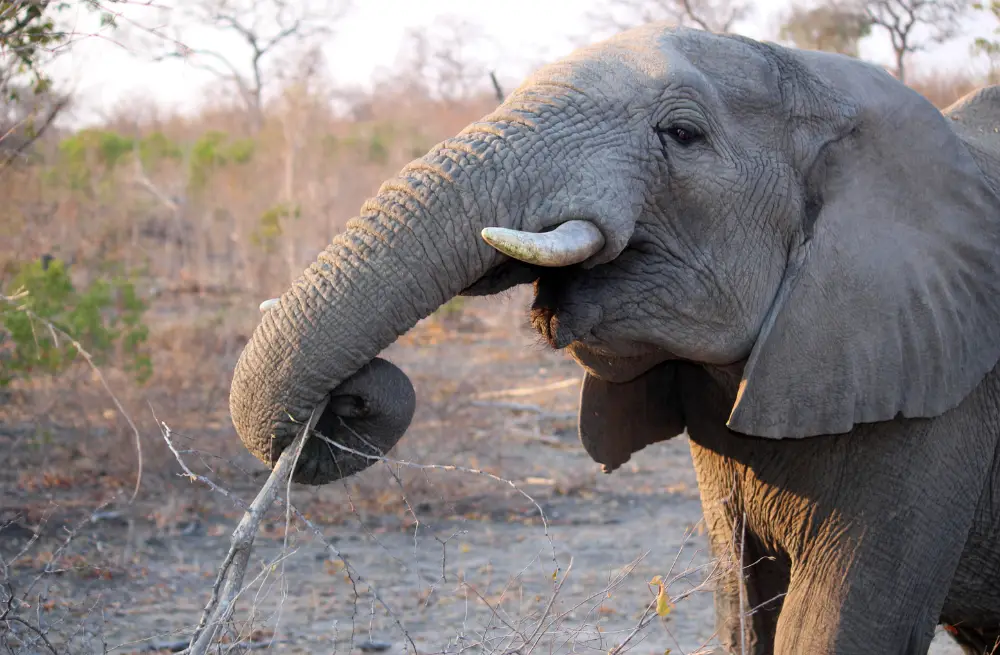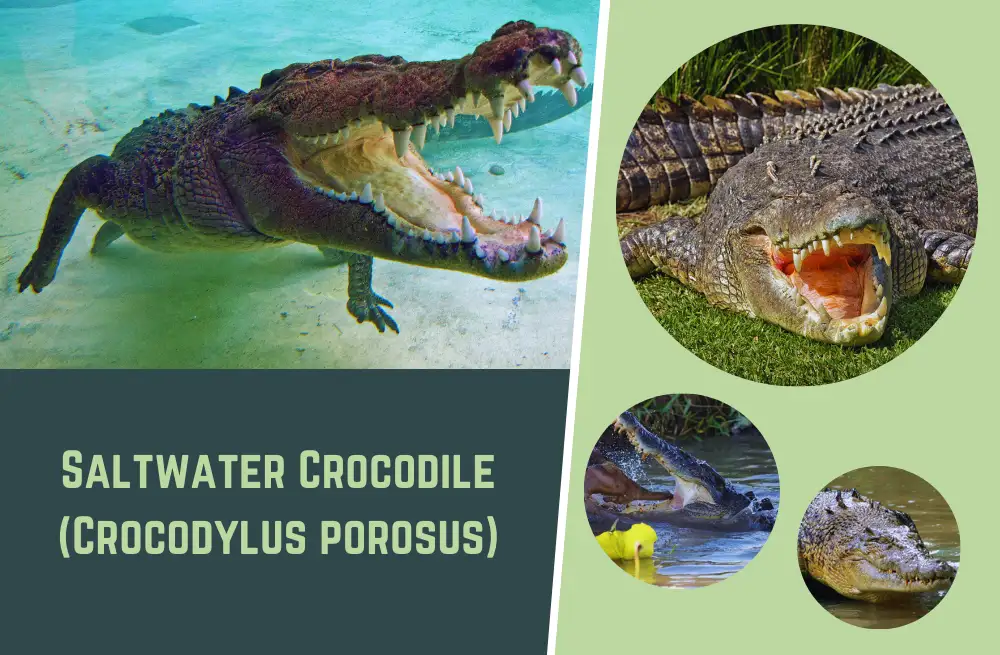Crocodiles in Florida: Species Profile, Photos & Information
Florida is home to a diverse range of wildlife, including both alligators and crocodiles. While these two reptiles may look similar at first glance, there are some key differences between them.
In this post, we’ll take a closer look at the crocodiles that live in Florida, including the American crocodile and the Cuban crocodile.
We’ll explore their habitats, behaviors, and conservation status to help you better understand these fascinating creatures.
Whether you’re a nature enthusiast or simply curious about Florida’s wildlife, read on to learn more about what crocodiles live in Florida.
| Species Name | Scientific Name | Size | Diet | Habitat | Conservation Status |
|---|---|---|---|---|---|
| American Crocodile | Crocodylus acutus | Up to 20 feet | Fish, birds, small mammals, and reptiles | Mangrove swamps, estuaries, and coastal lagoons | Threatened |
| American Alligator | Alligator mississippiensis | Up to 14 feet | Fish, birds, mammals, and reptiles | Freshwater marshes, swamps, and rivers | Least Concern |
| Cuban Crocodile | Crocodylus rhombifer | Up to 10 feet | Fish, birds, and small mammals | Freshwater marshes and swamps | Endangered |
| Spectacled Caiman | Caiman crocodilus | Up to 6.5 feet | Fish, birds, and small mammals | Freshwater habitats including rivers, streams, and wetlands | Least Concern |
Crocodile vs. Alligator: What’s the Difference?
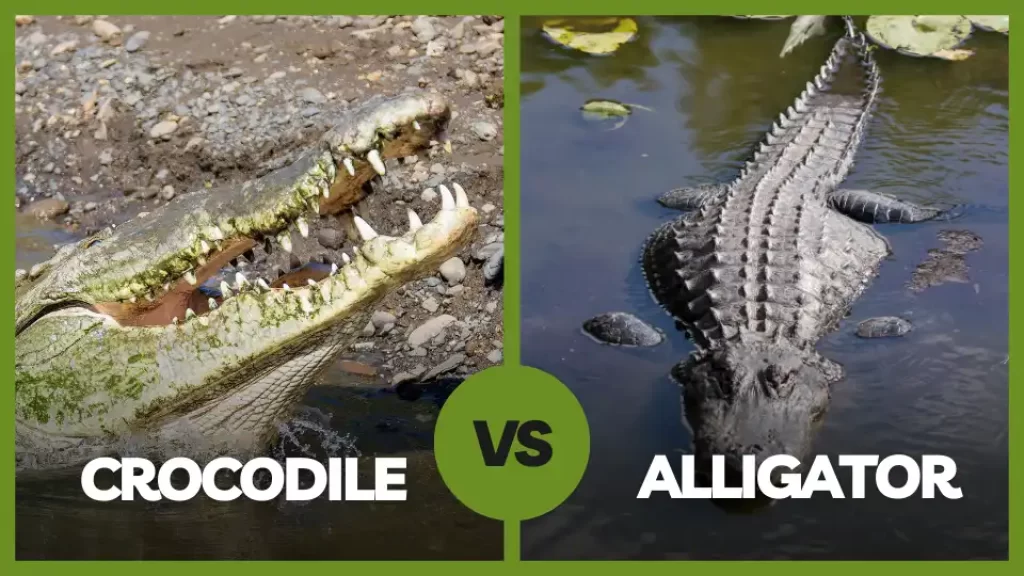
Alligators and crocodiles are two of the most commonly known reptiles in the world. Although they may look similar at first glance, there are significant differences between them that set them apart from each other. In this section, we will discuss the major differences between alligators and crocodiles.
Snout Shape
One of the most noticeable differences between alligators and crocodiles is their snout shape. Alligators have a wider and more rounded snout, while crocodiles have a longer and more pointed snout. This difference in snout shape reflects their feeding habits.
Alligators primarily eat fish, turtles, and small mammals, while crocodiles tend to eat larger prey such as zebras or wildebeests.
Salt Gland
Another significant difference between alligators and crocodiles is the presence of a salt gland in their tongue.
Crocodiles have a salt gland that allows them to excrete excess salt from their bodies, which helps them survive in saltwater environments. On the other hand, alligators do not have this adaptation and are typically found in freshwater habitats such as swamps, lakes, and rivers.
Habitat Range
Alligators have a much wider range than crocodiles. They can be found in several states across the United States including Florida, Louisiana, Georgia, Alabama, Mississippi, Arkansas, North Carolina, South Carolina, and Texas. Conversely,crocodiles are only found in southern Florida.
Aggressiveness
Crocodiles are generally more aggressive than alligators due to their territorial nature. They will attack humans more frequently as a result of feeling threatened or defending their territory against intruders.
Evolutionary History
The major differences between alligators and crocodiles result from their evolutionary history and adaptations to their respective environments.
Crocodile ancestors evolved over 200 million years ago during the Mesozoic era when dinosaurs roamed the earth while alligator ancestors evolved around 37 million years ago during the Cenozoic era.
Native and Non-Native Crocodile Species in Florida
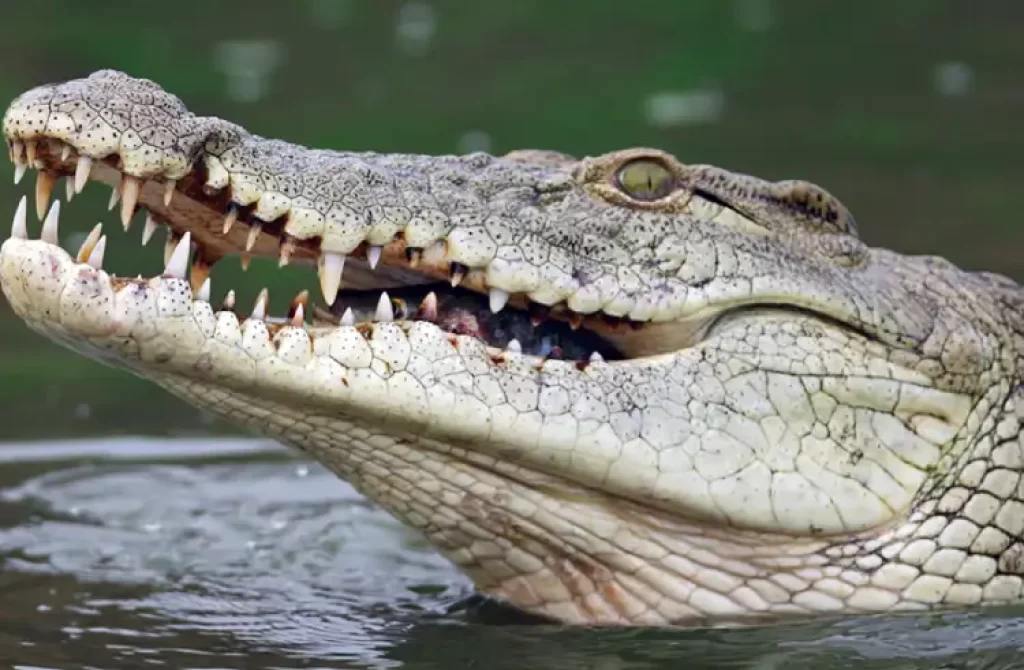
Florida is home to two native crocodile species: the American crocodile and the Florida crocodile. These species are an essential part of the state’s ecosystem, but they face various threats that endanger their survival.
The American crocodile is listed as a threatened species under the Endangered Species Act, with an estimated population of around 2,000 individuals in Florida.
This species can be found in coastal areas from southern Florida to South America. The American crocodile is one of the largest reptiles in North America, with males reaching up to 18 feet long and weighing over 2,000 pounds.
The Florida crocodile, on the other hand, is a subspecies of the American crocodile and is found only in southern Florida. It is also considered a threatened species due to habitat loss and human activities such as poaching. The population of this subspecies has declined significantly over time due to habitat destruction caused by urbanization.
In addition to these native species, there are also non-native crocodile species that have been introduced to Florida, such as the Nile crocodile and the spectacled caiman.
These non-native species pose a threat to the native crocodiles and their habitats because they can compete for resources and potentially hybridize with them.
The Nile crocodile is one of Africa’s largest freshwater predators, known for its aggressive behavior towards humans.
It was introduced into southern Florida through accidental or intentional releases from captivity. The Nile crocodile can grow up to 20 feet long and weigh over 1 tonne.
The spectacled caiman is another non-native species found in Florida that poses a threat to native wildlife. This small-sized predator can grow up to 8 feet long and weighs around 100 pounds on average. They were first introduced into southern Florida during the pet trade boom in the late 1970s.
Efforts are being made to manage these non-native species and protect the native crocodiles, including through habitat restoration and monitoring programs. The Florida Fish and Wildlife Conservation Commission (FWC) is responsible for managing these species in Florida.
The FWC has implemented various measures to control the population of non-native crocodile species in Florida.
One such measure is the removal of eggs and hatchlings from nests found outside their natural range. This strategy aims to prevent the establishment of new populations of non-native crocodiles.
Another approach is to capture and remove adult crocodiles that pose a threat to public safety or are found outside their natural range.
The FWC also conducts surveys to monitor the population status of both native and non-native crocodile species in Florida.
Habitat restoration projects are another critical aspect of protecting native crocodile species in Florida. These projects aim to restore degraded habitats, such as mangrove forests, which provide essential nesting sites for crocodiles.
You might also like: We have an informative article about crocodile lifespan, covering various factors that affect it such as species, habitat, and diet.
The Common or Spectacled Caiman in Florida
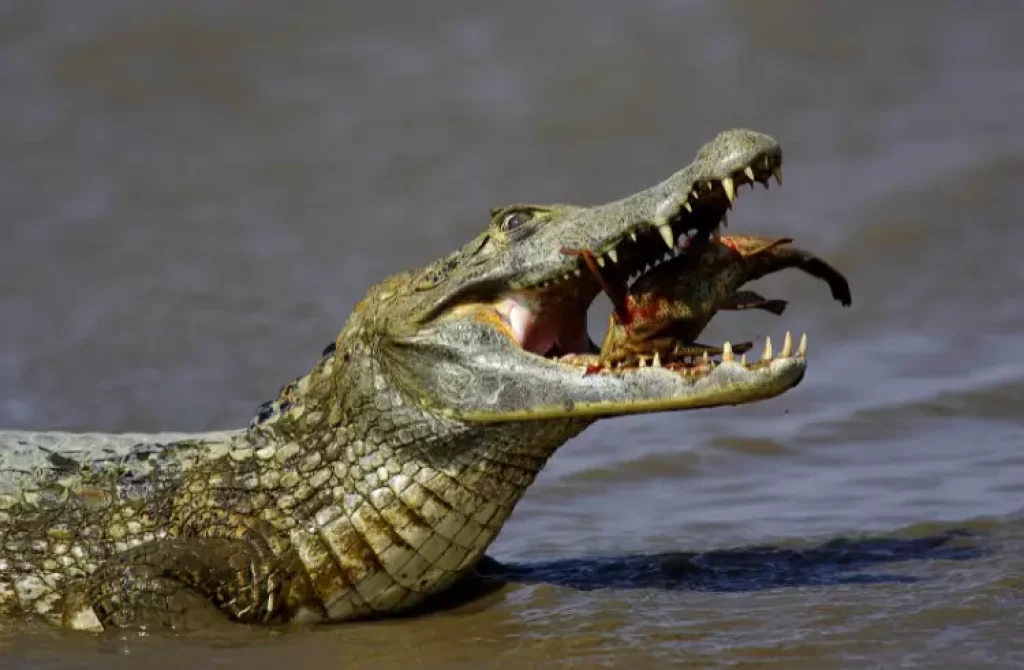
The Common or Spectacled Caiman (Caiman crocodilus) is a species of crocodilian that can be found in Florida’s canal system.
These reptiles are part of the Alligatoridae family and are closely related to alligators, caimans, and gharials. The Common or Spectacled Caiman is native to Central and South America but has been introduced into Florida through the pet trade.
Management by the Florida Fish and Wildlife Conservation Commission
The Florida Fish and Wildlife Conservation Commission regulates the management of caimans in the state to ensure their protection and prevent them from becoming a threat to humans.
In 2010, it became illegal to import, possess, sell, or breed caimans in Florida without a permit. This regulation was put in place due to concerns about public safety and environmental impact.
Caimans are not typically aggressive towards humans unless they feel threatened or provoked. However, they have been known to attack if they perceive a person as prey or if they mistake them for food.
It is important for people living near areas where caimans are present to take precautions such as staying away from the water’s edge at night when these creatures are most active.
Canal System Habitat
Florida’s canal system provides an ideal habitat for Common or Spectacled Caimans due to its warm climate, abundant vegetation, and access to freshwater sources. These reptiles can be found near canals, rivers, lakes, swamps, and other bodies of water throughout southern Florida.
Mating Season Behavior
During mating season (which occurs between April and May), male caimans will emit a loud bellowing sound to attract females and establish their territory. The males will also engage in physical combat with each other over potential mates.
Once a female has been attracted by a male’s call, the two will engage in courtship behavior that includes touching and rubbing against each other. After mating, the female will lay her eggs in a nest made of vegetation near the water’s edge.
American Crocodile: Native and Non-Aggressive
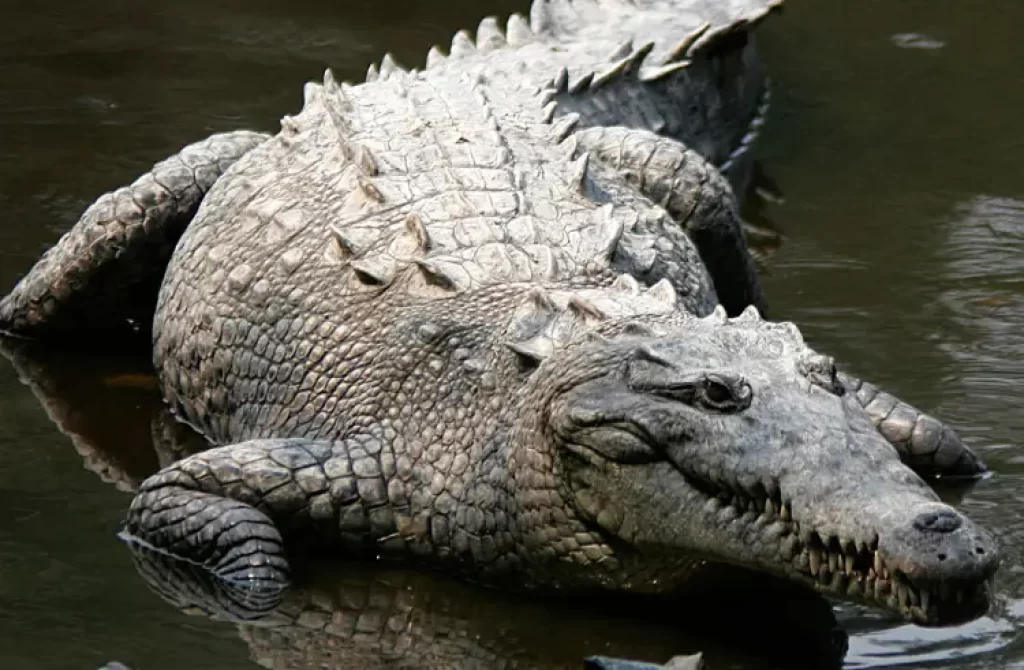
The American crocodile is a fascinating species that is native to Florida. Unlike the American alligator, which is often portrayed as an aggressive predator, the American crocodile is non-aggressive towards humans and prefers to hunt its natural prey such as fish, crustaceans, and small mammals. This makes it a relatively safe animal to be around in the wild.
Natural Habitat
The American crocodile can be found in the wild in freshwater habitats such as rivers, lakes, and marshes. They are also known to inhabit brackish waters near coastal areas. These habitats provide the perfect environment for them to thrive as they have access to their natural prey.
Conservation Efforts
Despite being a non-aggressive species towards humans, the American crocodile has been listed as a threatened species by the United States Fish and Wildlife Service due to habitat loss and human interference with their nesting sites. This highlights the importance of conservation efforts to protect this magnificent creature from extinction.
Natural History
The natural history of the American crocodile is fascinating. Female crocodiles build their nests on elevated areas near water sources, where they lay their eggs. The males will often guard the nest while the female is away hunting for food.
Once hatched, baby crocodiles are left alone by their mother who returns only occasionally to check on them.
Nesting
Nesting season for American crocodiles usually occurs between April and July when females lay between 20-60 eggs per clutch. The incubation period lasts approximately 80 days before hatchlings emerge from their eggs.
Person-Crocodile Encounters
While it’s rare for people to encounter an American crocodile in Florida’s wilderness areas, there have been instances where people have come into contact with these creatures without incident.
In most cases, these encounters occur when people accidentally stumble upon a nesting site or cross paths with a crocodile while fishing or boating.
Male and Female Crocodiles
Male crocodiles are typically larger than females, with some reaching up to 20 feet in length. Females, on the other hand, usually grow to be around 10 feet long. Despite their size difference, both males and females are equally important to the survival of the species.
Natural Prey
The American crocodile’s natural prey includes fish, crustaceans, and small mammals such as rodents.
They have also been known to eat birds and other reptiles such as snakes. While they may occasionally take down larger prey such as deer or wild pigs, this is not a common occurrence.
Crocodiles vs. Alligators: How to Tell the Difference
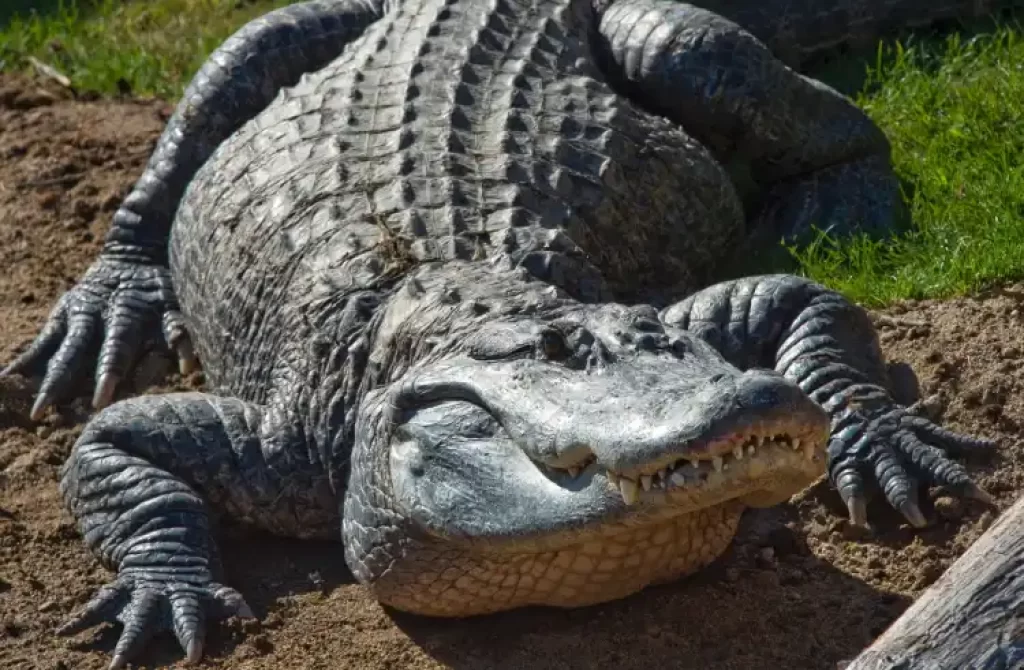
Crocodiles and alligators are often confused with each other because of their similar appearance, but they have distinct differences that set them apart. In this section, we will discuss how to tell the difference between crocodiles and alligators by examining their physical characteristics, behavior, and habitat.
Physical Characteristics
One of the most noticeable differences between crocodiles and alligators is their snout shape. Crocodiles have a V-shaped snout, while alligators have a U-shaped snout. The shape of their snouts is related to their diet and hunting habits.
Crocodiles typically hunt in open water, so they need a V-shaped snout to help them swim faster and catch prey more easily.
Alligators usually hunt in shallow water or on land, so they need a U-shaped snout for greater strength when biting down on prey.
Another distinguishing feature is the number of teeth visible when their mouth is closed. Crocodiles have a pointed fourth tooth that protrudes from their lower jaw even when their mouth is closed, while alligators do not have this feature. This tooth has earned crocodiles the nickname “fourth tooth” or “toothpick.”
Behavior
Crocodiles are generally more aggressive than alligators and will attack humans more frequently. They are also known for being able to tolerate saltwater habitats better than alligators due to special glands that allow them to excrete excess salt from their bodies.
On the other hand, alligators prefer freshwater habitats such as swamps, rivers, lakes or marshes.
Habitat
Crocodile species can be found in many parts of the world including Africa, Asia, Australia & America whereas Alligator species can only be found in China & America.
In general terms ,crocodile prefers saltwater habitats like oceans , seas etc whereas Alligator prefers freshwater habitats like swamps, rivers, lakes or marshes.
Color
Crocodiles have a lighter color body compared to alligators, which are darker in color. The difference in their skin color is due to the type of habitat they live in.
Crocodiles that live in saltwater habitats tend to have a lighter coloration because it helps them blend in with the sandy bottom of the ocean floor.
Alligators that live in freshwater habitats tend to have a darker coloration because it helps them blend in with the murky water and shadows of their environment.
Tail
Another difference between crocodiles and alligators is their tail shape. Crocodiles have a longer, more pointed tail than alligators. This feature helps crocodiles swim faster and more efficiently through open water.
Alligators have a broader, more rounded tail that provides greater strength for swimming through shallow water or on land.
Where to Find Florida’s Crocodiles: Rookery Bay and Tampa Bay

Rookery Bay is a prime location for spotting Florida’s crocodiles due to its extensive mangrove forests and shallow waters.
The bay is home to a significant population of American crocodiles, which can be seen basking on the banks or swimming in the water. Visitors can take guided tours or rent kayaks to explore the bay and increase their chances of spotting these elusive reptiles.
One reason why Rookery Bay is an ideal place to spot crocodiles is because of its unique ecosystem. Mangrove forests are essential habitats for many species, including crocodiles.
These trees provide shelter and food for various animals that live in the bay, making it an attractive location for crocodiles.
Another reason why Rookery Bay is a great place to see crocodiles is that it has shallow waters. Crocodiles prefer shallow waters because they can easily hunt prey in these areas. Additionally, they can regulate their body temperature by moving between water and land.
Visitors who want to explore Rookery Bay have several options available to them. Guided tours are available that provide visitors with an opportunity to learn about the ecosystem and see wildlife up close.
Kayak rentals are also available, allowing visitors to explore the bay at their own pace.
It’s important to remember that while observing crocodiles in their natural habitat can be exciting, it’s crucial always to maintain a safe distance from them. Crocodiles are wild animals and should not be approached or disturbed in any way.
Tampa Bay is another location where visitors can spot Florida’s crocodile population. Tampa Bay has been home to American crocodiles since prehistoric times when sea levels were higher than they are today.
One of the best places to see crocodiles in Tampa Bay is at Cockroach Bay Preserve State Park. This park provides visitors with an opportunity to observe these reptilian predators up close while also enjoying other outdoor activities such as hiking and fishing.
Another location in Tampa Bay where crocodiles can be spotted is the Alafia River State Park. This park has several hiking trails that provide visitors with an opportunity to see crocodiles in their natural habitat. Visitors should always keep a safe distance from these animals and avoid disturbing them.
In addition to Rookery Bay and Tampa Bay, there are other locations throughout Florida where visitors can spot crocodiles.
The Everglades National Park is one of the most popular places to see these reptiles. The park has several guided tours available that provide visitors with an opportunity to learn about the ecosystem and see wildlife up close.
Are There Crocodiles in the Everglades National Park?

The Everglades National Park is a unique and beautiful ecosystem that is home to a wide variety of wildlife, including two species of crocodiles: the American crocodile and the more common American alligator.
While both species can be found throughout the park, the American crocodile is a rare and endangered species that can only be found in South Florida, including the Everglades National Park.
The American crocodile is a fascinating creature that has adapted to life in the brackish waters of South Florida’s wetlands. These reptiles are known for their long snouts, powerful jaws, and sharp teeth, which they use to catch fish, crustaceans, and other small animals. They are also excellent swimmers and can hold their breath underwater for up to an hour.
The Everglades is an ideal habitat for crocodiles due to its vast wetlands, mangrove swamps, and brackish waters.
These areas provide plenty of food sources for these creatures as well as safe places to rest and breed. Crocodiles in the Everglades are usually found in the southern part of the park, particularly in Florida Bay and the coastal areas of the Gulf of Mexico.
While both crocodiles and alligators can be dangerous if provoked, visitors to the Everglades National Park should be especially cautious when exploring its waterways. Both species have been known to attack humans if they feel threatened or cornered.
It’s important to remember that these animals are wild creatures that should be respected from a distance.
Despite their fearsome reputation, American crocodiles play an important role in maintaining balance within their ecosystem. As top predators, they help keep populations of smaller animals in check while also providing food for larger predators such as panthers and bears.
In recent years, efforts have been made to protect and conserve American crocodile populations within South Florida’s wetlands.
The Everglades National Park has implemented a number of measures to help protect these creatures, including habitat restoration projects and public education campaigns designed to raise awareness about the importance of conservation.
The Crocodiles of South Florida
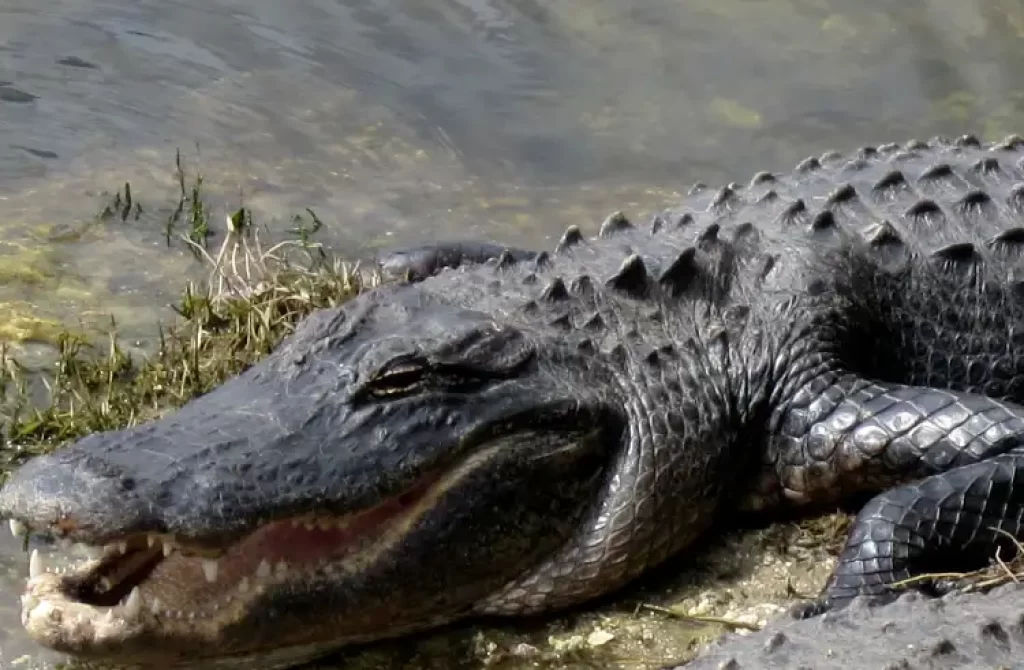
South Florida is home to two species of crocodilians: the American alligator and the American crocodile (Crocodylus acutus). While both species are similar in appearance, there are subtle differences that set them apart.
The American crocodile is a rare and endangered species that can only be found in southern Florida, particularly in the Florida Keys and Everglades National Park. This makes it a unique and important part of the ecosystem.
The American crocodile is a large reptile that can grow up to 20 feet long and weigh over 2,000 pounds.
Despite being called the “American” crocodile, this species can also be found in other parts of the world, including Central and South America, and the Caribbean. However, their population is declining globally due to habitat loss and hunting.
Crocodile Habitat
Crocodiles need specific habitats to survive. They require warm water for breeding and basking, as well as areas with dense vegetation for nesting.
In southern Florida, they typically live in mangrove swamps or coastal lagoons where they have access to both fresh and saltwater environments.
Adult Crocodiles
Adult crocodiles are apex predators that play an important role in controlling populations of smaller animals such as fish and crabs.
They have powerful jaws that allow them to catch prey quickly, but they are also capable of waiting patiently for hours until their prey comes within striking distance.
Florida Fish
Crocodiles in South Florida primarily feed on fish, crabs, and other small animals found in creeks and estuaries.
However, they have also been known to prey on larger animals such as Burmese pythons and even alligators. This makes them an important part of the food chain.
Florida Keys
The Florida Keys are an important habitat for American crocodiles because they provide a safe haven away from human development.
However, this also means that they are vulnerable to the effects of climate change, such as sea level rise and increased storm activity.
Florida Museum
The Florida Museum of Natural History is a fascinating place to visit, especially for nature enthusiasts and those interested in learning more about Florida’s natural heritage. Inside the museum, you’ll find an impressive collection of crocodilian specimens, including alligators and crocodiles.
This collection is incredibly valuable, as it allows researchers to study these amazing creatures in greater detail, providing insights into their behavior, ecology, and conservation needs.
But the museum isn’t just about crocodilians. It also features exhibits on Florida’s prehistoric life, including fossils of mammoths and mastodons that once roamed the state. Visitors can explore displays on Florida’s diverse ecosystems, from its stunning beaches and wetlands to its sprawling pine forests. And there’s something for everyone here, from kids to adults, with a range of educational programs and activities available, such as field trips, workshops, and summer camps.
Beyond its educational offerings, the Florida Museum of Natural History is also a hub for scientific research and conservation efforts, working to protect Florida’s natural resources and promote environmental stewardship.
Nile Crocodiles
The Nile crocodile, which is native to Africa, has been spotted in South Florida in recent years. This is likely due to the exotic pet trade, where people purchase these animals as pets and then release them into the wild when they become too difficult to care for.
This poses a threat to both humans and native wildlife because Nile crocodiles are much larger and more aggressive than American crocodiles.
Reptiles
Crocodiles are just one example of the many reptile species that call southern Florida home. Other species include snakes, lizards, turtles, and iguanas. These animals play important roles in maintaining the delicate balance of the ecosystem.
Creeks
Creeks are an important habitat for many aquatic species including fish, crabs, and even crocodiles. They provide a source of food and shelter from predators.
Crabs
Crabs are a common prey item for crocodiles in South Florida. They can be found in creeks and estuaries throughout the region.
Burmese Pythons
Burmese pythons are an invasive species that have taken over parts of southern Florida. They pose a threat to native wildlife because they prey on small mammals such as raccoons and rabbits. However, adult pythons have also been known to fall prey to American crocodiles.
Final thoughts: What We Know About Florida’s Crocodile Population
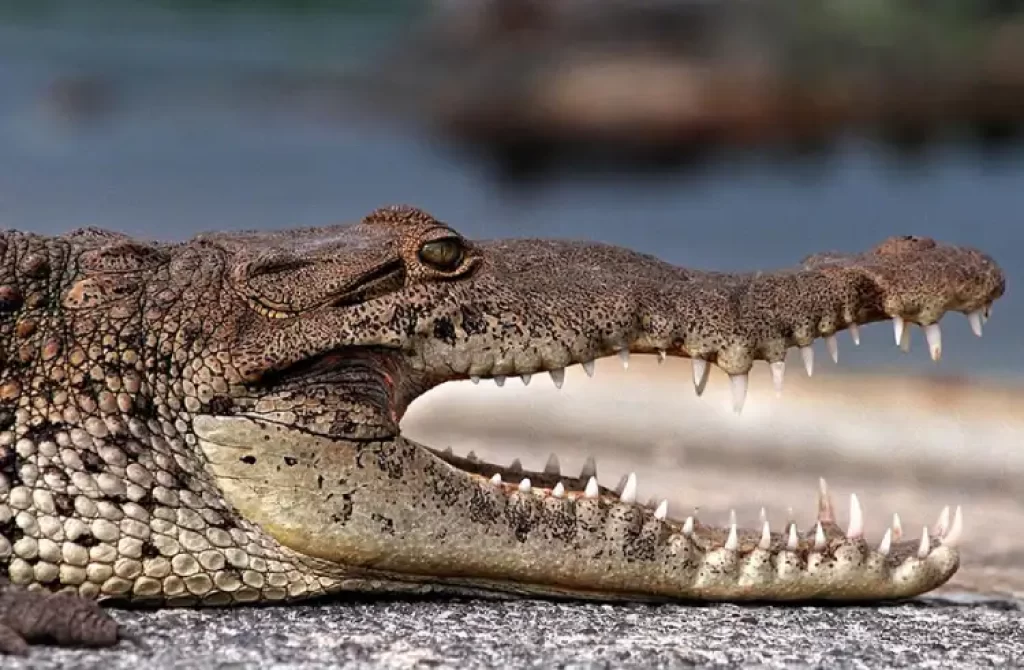
The crocodile population in Florida is a fascinating topic that has garnered much attention over the years. With both native and non-native species residing in the state, it is important to understand their differences and behaviors.
The American crocodile is one of two native species found in Florida. Although they can be aggressive towards humans, they are generally non-aggressive and tend to avoid confrontation.
The common or spectacled caiman is a non-native species that has been introduced into the state through the pet trade. While they may not pose a significant threat to humans, they can have negative impacts on native wildlife.
Crocodiles and alligators are often confused for one another, but there are distinct differences between them.
Crocodiles have longer snouts and V-shaped heads, while alligators have shorter snouts and U-shaped heads. Additionally, crocodiles tend to prefer saltwater habitats while alligators prefer freshwater habitats.
Florida’s crocodile population can be found primarily in Rookery Bay and Tampa Bay. However, there have been sightings of crocodiles in other areas such as the Everglades National Park.
It is important to note that these sightings do not necessarily indicate a breeding population.
Overall, the status of Florida’s crocodile population remains somewhat uncertain due to limited data on their numbers and distribution.
Efforts are being made to monitor their populations and protect their habitats from human encroachment.
As we continue to learn more about these fascinating creatures, it is important that we strive to maintain a healthy balance between human activity and wildlife conservation efforts.
By doing so, we can ensure that future generations will be able to enjoy Florida’s unique ecosystem for years to come.
Other Informative Links
- Florida Museum of Natural History Florida Natural Areas Inventory
- How Fast Can a Crocodile Swim?
- University of Florida IFAS
- Morelet’s Crocodile (Crocodylus moreletii)
- Saltwater Crocodile (Crocodylus porosus)
- American Alligator (Alligator mississippiensis)
- Nile Crocodile (Crocodylus niloticus)
- Mugger Crocodile (Gavialis gangeticus)
- Orinoco Crocodile (Crocodylus intermedius)
- Cuban Crocodile (Crocodylus rhombifer)
- African Dwarf Crocodile (Osteolaemus tetraspis)
References
Fishman, J., K. MacKinnon and S. Baker. 2009. “Crocodylus acutus” (On-line), Animal Diversity Web. Accessed June 01, 2011 http://animaldiversity.ummz.umich.edu/site/accounts/information/Crocodylus_acutus.html.
Florida Museum of Natural History. (n.d.). American Crocodile. Retrieved May 20, 2011, from Herpetology: http://www.flmnh.ufl.edu/cnhc/csp_cacu.htm.
Florida Natural Areas Inventory. 2001. Field guide to the rare animals of Florida. https://www.fnai.org/FieldGuide/pdf/Crocodylus_acutus.pdf.


